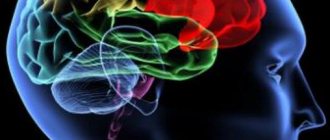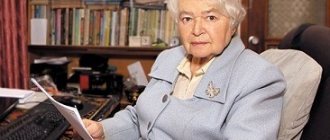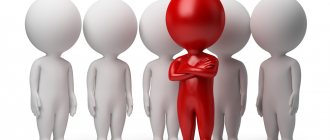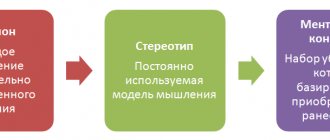Action as an element of activity
The word “element” is often associated with something small and insignificant. But if we consider that everything consists of interconnected particles, then the significance of each of them in the overall structure of the object becomes obvious. Unequal replacement, rearrangement, or loss of one element can lead to a change in the properties and qualities of the item as a whole (not always for the better).
Any work - productive or unproductive - consists of a number of individual actions arranged in a certain sequence. To obtain the intended result, a person must act systematically, rationally, using the necessary tools, devices, materials, etc. That is, such elementary parts of an activity as actions determine its success if their selection is correct and the sequence is logical. Chaoticity, redundancy or insufficiency is the cause of useless work, whatever it may be.
Focus and motivation
The result of an individual’s activity depends on motivation, which can be external and internal. Extrinsic motivation may involve gaining approval from others. Intrinsic motivation lies in the interest of the individual himself to complete a specific task. Internal motivation has a much better effect on a person, because in this way he develops himself. The better motivated a person is, the more he believes in his own abilities and the more desire he has to work to achieve his goal.
It is extremely important that a person understands why he is doing his work, only in this case he will do it efficiently. If work does not provide any benefits and does not bring you closer to the goal, then any person will quickly get bored with it.
What is human activity
Like many representatives of the animal world, man is a doer. He is able to change and improve his own environment and living conditions as a result of work and his inherent transformative attitude towards the environment.
In nature there is no such object (living or non-living) as an “activity”: it cannot be drawn or photographed. However, activity and person do not exist separately.
Visible conscious changes in living conditions are one of its results; it is productive. The other is internal changes, self-improvement. Man, working, discovered, learned and invented new ways of developing his own mental, physiological, and mental processes. That is, being an active subject, he has the object of his transformations not only the whole world, but also himself, his society.
Motives and activities
What motivates people to act? This is a motive, a reason, the need to satisfy some kind of personal need (physiological, spiritual, social), pushing a person to active actions. They are formed under the influence of upbringing, social relations, culture, and customs.
What does an individual do during his life? Play, study, work - these are the main types of his activities. They are mastered gradually, as his psychophysiological development progresses. One of the types becomes predominant, which satisfies the basic needs of a person and corresponds to his capabilities. So play, being the main type of activity for a child, is replaced by educational (school, vocational education), and then work.
Peculiar types of human activity are creativity and communication.
The result of creativity is something new in science, art, and the production of material assets. The desire for communication is explained by a person’s need to satisfy both material and spiritual needs.
Structure
- Finding yourself begins with the first step - with attraction. This is a primitive form, here the need still remains unconscious.
- When it becomes conscious, attraction develops into desire. Already at this stage, a person begins to think through methods for its implementation. Directly through desires a person comes to a goal.
- If an individual becomes able not only to dream, but also to make certain efforts, desire turns into aspiration. Quite often at this stage the individual has a plan of action.
- Against the backdrop of the desire to learn new things, interest is born. It gives meaning to any activity of an individual. You can already judge by interests what a person is like.
- When serious work is added to interest, it turns into addiction. A person does not want to leave this type of activity and constantly returns to it, feeling a burning desire to engage in it. He is ready to spend a lot of time on mastering new skills and will strive to achieve impeccable performance.
- An ideal is a picture, a perfect image in a person’s head, to which he strives and what he wants to achieve in the chosen direction.
- The next step is worldview. These are the laws that a person relies on in life. With their help, he makes plans for the future and chooses a style of behavior in different circumstances. Worldview is a view of the people around you, the world as a whole and your place in it.
- According to psychology dictionaries, the highest form of human orientation is conviction.
Volitional personality traits - what is it in psychology, their formation
Belief
All these steps of the substructure are strongly interconnected; it is difficult to say where exactly the line between attraction and desire is, when desire turns into interest. Direction begins with an unconscious attraction and develops into a conviction. However, it cannot be said that the components of a personality’s direction are formed once and for all; they do not stand still, change, and develop throughout human life.
Classification of actions (psychology)
Any type of activity is possible with the sequential implementation of specific actions. Psychology calls four types of them:
| Types of actions | Description, examples |
| Instinctive | That is, genetic, unconscious. For example, during a fire, a mother rushes to save her child, despite a mortal threat to herself (maternal instinct). Instinct can cause conscious actions - the same mother is looking for optimal means and ways of escape from a fire |
| Reflex | Reactions to irritants that are not conscious to a person: rubbing a sore spot, coughing in a smoky room |
| Impulsive | a) Unconscious reaction to surprises of any nature: the exclamation “Wow!” typical for a frightened person and for an unexpectedly happy one. b) Partially conscious impulsive actions: a person frightened during an attack takes defensive measures |
| Strong-willed | Basic, conscious actions. For example, trained to work with a book, a student correctly builds a chain of his actions: carefully read the text several times, highlight the main theme, the main characters, give them a description, etc. |
For humans, the main types of actions are volitional. A well-mannered person knows how to subordinate his instincts to his will and act reasonably thoughtfully in critical situations when an excess of emotions can partially or completely turn off rational thinking.
Expectancy theory
In 1964, the theory of motivation was outlined in the scientific work of the American researcher Victor Vroom “Work and Motivation”, which is currently considered fundamental. The stimulating effect, according to this theory, is produced not by the presence of certain needs of the individual, but by the thought process when the reality of achieving the goal that has been set is assessed, as well as receiving one or another reward for this (this can be material benefits or the satisfaction of ambition - not that important).
Subsequently, V. Vroom's model was significantly supplemented by famous scientists E. Lawler and L. Porter. They conducted joint research and found out what determines the results that a subject achieves in a particular type of activity. It depends on the “cost”, that is, the value of the reward, on the degree of satisfaction in reality, on the perceived and actually expended effort, on the individual characteristics and abilities of the person (no amount of motivation will help a pianist unsuited to the keys to grow long fingers, like Chopin’s, or not become a ballerina if you were not born with a high and flexible instep). In addition, a person must be clearly aware of his role in the labor process (role perception).
From this concept we can conclude that the results of professional activity should lead to an increase in human satisfaction, and this is the strongest motive. But there is also an inverse relationship. There is also satisfaction with the simple feeling of completed work, which also greatly accompanies further productivity, develops a creative approach to professional responsibilities and increases the value of the work invested. It should be noted that scientists in the USSR devoted a lot of work to this very topic, and their research was no less successful than the work of their foreign colleagues.
Sociology: classification of actions according to M. Weber
Every day a person performs so-called social actions that have the goal of influencing other people in one way or another.
According to the classification of M. Weber (sociologist, 1865-1920, Germany), there are the following types of actions:
- Purposeful, that is, having a practical goal and thoughtful means of achieving it. Such actions are organized, for example, by a doctor when treating a patient, foreseeing what complications may arise, what means of treatment and prevention should be used.
- Value-based and rational actions are caused by the moral and moral attitudes of the individual. The actions of many WWII heroes were dictated by feelings of patriotism and duty to defend the Fatherland.
- Affective - caused by strong feelings (fear, love). For example, a young man jumps off a cliff to prove his feelings to a girl.
- Traditional actions are repeated in similar situations when customs must be observed (funerals, weddings, honoring heroes, organizing and holding holidays).
According to Weber, a person’s actions are dictated by his personal motives and his expectation of the reaction of others (approval, condemnation).
Personality formation and socio-political conditions
The dynamic side of orientation, highlighted by Rubinstein, involves changes in the orientation of the individual in connection with the modification of social realities. The famous scientist B. G. Ananyev also noted this in his works, speaking about the dependence of changes in goals, motives, levels, methods, results on the class position, in particular, the child’s family or, in general, the entire social formation.
It is these conditions that determine the specific form of labor: will it be physical or mental and what will be the system of production relations. The socio-political situation in which the formation of personality occurs most directly influences the results of the subject’s choice of profession and his further functioning on one or another path.
The conclusions of the outstanding scientist A. Maslow, the author of the remarkable pyramid of needs, presented humanity with a classification of groups that described the dynamics of personality transformation under the influence of the existing conditions. It was he who came to the conclusion about the priority needs that require satisfaction: first the simplest and most urgent ones - food, housing, then the rest, moving from level to level. This is what determines the behavior and professional orientation of the subject.
Action as a form of action
Actions, like a mirror, reflect the moral essence of a person, since they are dictated by a conscious choice between “good” and “bad.” This form of action is a component of behavior that is consistent or inconsistent with the rules and norms accepted in society.
Any action has its own purpose and implementation plan, dictated by the person’s intentions. Its consequences do not always coincide with those expected, and it is characterized as rash and frivolous.
The action can be expressed:
- directly in physical action (picking up a fallen object and giving it to the person who dropped it);
- verbal (support with a word, approve or condemn someone);
- in demonstrating attitudes to events, to other persons, to their actions, words (irony, gesture, body movements, gaze);
- inaction (failure to comply with orders from a superior, failure to provide assistance to someone in distress).
An action is inevitably assessed from the outside in accordance with the moral standards accepted in society (or group). Even theft, for example, can be approved in an asocial environment, as a sign of dexterity and fearlessness.
A person is certainly responsible for any activity, for his actions, even if its prospects seem unclear or distant.
conclusions
Based on everything stated above, a person’s orientation towards a certain profession can be considered a certain internal predisposition, inclinations, inclinations, abilities, motivation for a specific occupation. These are collectively the individual traits and properties of a person, his qualities, value orientations, motives and views. And at the same time, professional aspirations characteristic of a particular activity, the readiness to apply all of the specified components while performing job duties.
The components of a professional orientation must include the ability to perform this type of activity, as well as many individual qualities of a person, his worldview, which includes his system of values, his ideals, dominant motives with motivating needs in all their diversity. Here, certain “hygienic” factors are also necessary to ensure success in the chosen field of activity.
Source
Types of actions in educational activities
Each generation is forced to master the experience, knowledge, skills that were lost with the previous one, that is, it must learn. With the development of science and technology, with the renewal of social processes, the content, forms, and methods of teaching are modified, and new types of educational activities appear.
In modern society, good general and special education is highly valued. For a person, it is an open door to the most interesting world of professionals, and for society it guarantees the emergence of highly qualified and creative personnel capable of leading it along the road to progress.
The educational activities and types of actions of teachers and students differ because their functions differ: the former give knowledge, and the latter receive. The educator, teacher, parents, lecturer teach, that is, they are active subjects of this process. The objects of learning - pupils, students, participants in various courses - assimilate the concepts given to them and types of actions (mental, practical).
Education is a complex, long-term process that requires not only high-quality training, but also gradual and conscious mastery of educational activities and skills in working with information.
Solving cognitive problems is certainly accompanied by the development of students’ personal qualities. That is, by the end of training they must sufficiently master actions aimed at self-education, self-development, establishing communication connections and determining their place in society. A detailed list of them is presented in the Federal State Educational Standard.
Professional orientation
Each profession requires the possession of specific character traits that are necessary to achieve success in that field. In psychology, several personality types are defined:
- Realistic type
They prefer physical labor and working with real objects. The following professions suit them most: builder, technician, mechanic.
- Conventional type
The personality is attentive, focused and calm in nature. Such people are responsible and always complete their work on time. Preferred professions: librarian, merchandiser.
- Intelligent type
These people love to think and learn new information. They love to do research work. The most suitable professions: teacher, writer.
- Enterprising type
Such individuals have leadership qualities and are excellent at managing. The following professions are suitable: manager, businessman.
- Social type
People with a well-developed sense of empathy who strive to help others. The following professions are suitable: doctor, social worker.
- Artistic type
Such individuals do not like to work according to a schedule and put themselves into any kind of framework. They are unpredictable and creative. Best professions: artist, poet.
Legal and non-legal actions
The activities of law enforcement agencies are aimed at protecting the rights of citizens in accordance with the legislation adopted in the country.
Types of legal actions are determined on different grounds. For example, according to legislation, they can be divided into the following groups:
- legal, that is, corresponding to the rules of law: buying or selling real estate, going to court to protect one’s interests, etc.;
- unlawful, contrary to the law: various crimes, intentional and unintentional offenses.
Legal actions are carried out not only by lawyers, but also by workers in other fields of activity. For example, in order to certify that a business traveler has arrived at the enterprise, it is not necessary to go to the justice authorities: this will be done in the personnel department. Or: the marriage certificate is issued at the place of its registration in the registry office.








